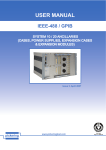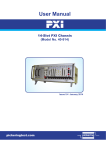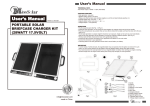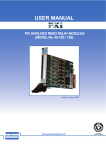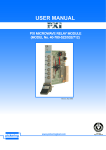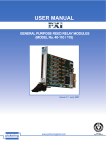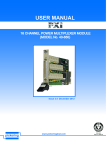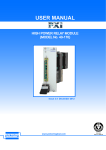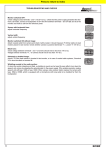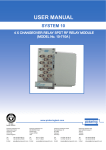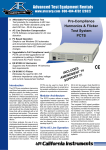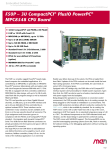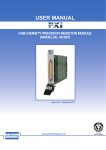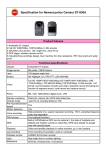Download Pickering 10-910
Transcript
pickering USER MANUAL IEEE-488 / GPIB SYSTEM 10 / 20 ANCILLARIES (CASES, POWER SUPPLIES, EXPANSION CASES & EXPANSION MODULES) Issue 3.1 July 2008 pickering www.pickeringtest.com SYSTEM 10 / 20 ANCILLARIES MANUAL ISO 9002 Reg No. FM38792 Page 1 pickering © Copyright (2008) Pickering Interfaces. All Rights Reserved. No part of this publication may be reproduced, transmitted, transcribed, translated or stored in any form, or by any means without the written permission of Pickering Interfaces. Technical details contained within this publication are subject to change without notice. Page ii SYSTEM 10 / 20 ANCILLARIES MANUAL pickering TECHNICAL SUPPORT For Technical Support please contact Pickering Interfaces either by phone, fax, the website or via e-mail. WARRANTY All products manufactured by Pickering Interfaces are warranted against defective materials and workmanship for a period of two years, excluding PXI chassis, from the date of delivery to the original purchaser. Any product found to be defective within this period will, at the discretion of Pickering Interfaces be repaired or replaced. Products serviced and repaired outside of the warranty period are warranted for ninety days. Extended warranty and service are available. Please contact Pickering Interfaces by phone, fax, the website or via e-mail. ENVIRONMENTAL POLICY Pickering Interfaces operates under an environmental management system similar to ISO 14001. Pickering Interfaces strives to fulfil all relevant environmental laws and regulations and reduce wastes and releases to the environment. Pickering Interfaces aims to design and operate products in a way that protects the environment and the health and safety of its employees, customers and the public. Pickering Interfaces endeavours to develop and manufacture products that can be produced, distributed, used and recycled, or disposed of, in a safe and environmentally friendly manner. Observe the Electrical Hazard Warning detailed in Section 9. Observe the Electrostatic Sensitive Device Caution detailed in Section 9. Worldwide Technical Support and Product Information http://www.pickeringtest.com Pickering Interfaces Headquarters Stephenson Road Clacton-on-Sea CO15 4NL United Kingdom Tel: +44 (0)1255-687900 Fax: +44 (0)1255-425349 E-Mail: [email protected] Pickering Interfaces Inc. 2900 Northwest Vine Street Grants Pass Oregon 97526 USA Pickering Interfaces GmbH Johann-Karg-Straße 30 D-85540 Haar-Salmdorf Germany Pickering Interfaces AB Karl Nordströmsväg 31 432 53 Varberg Sweden Tel: +1 541 471 0700 Fax: +1 541 471 8828 E-Mail: [email protected] Tel: +49 89 125 953 160 Fax: +49 89 125 953 189 E-Mail: [email protected] Tel: +46 340-69 06 69 Fax: +46 340-69 06 68 E-Mail: [email protected] Pickering Interfaces Inc. (East Coast Regional Office) 12 Alfred Street Suite 300-3 Woburn Massachusetts 01801 USA Pickering Interfaces s.r.o. Smetanova 525 ˇ Trinec 739 61 Czech Republic Pickering Interfaces SARL 6 Rue De La Mare Blanche 77186 Noisiel Marne Le Vallee France Tel: +1 781 897 1710 Fax: +1 781 897 1701 E-mail: [email protected] Tel: +42 0558 339 168 Fax: +42 0558 340 888 E-mail: [email protected] Tel +33 1 60 53 55 50 Fax +33 1 60 53 55 99 email [email protected] SYSTEM 10 / 20 ANCILLARIES MANUAL Page iii pickering THIS PAGE INTENTIONALLY BLANK Page iv SYSTEM 10 / 20 ANCILLARIES MANUAL pickering CONTENTS Copyright Statement..............................................................ii Technical Support and Warranty..........................................iii Contents (this page)...............................................................v Section 1 Enclosures...........................................................................1.1 Case Dimensional Data............................................1.1 System 10 Case Schematic Diagrams....................1.1 Mixed System 10/20 Case Schematic Diagrams....1.1 Section 2 System Backplanes.............................................................2.1 Overview....................................................................2.1 Backplane Layout.....................................................2.1 Section 3 Power Supplies....................................................................3.1 Features.....................................................................3.1 Power Supply Up/Down Sequencing Option..........3.1 Typical Driving Capability........................................3.1 Using External Power Supplies...............................3.1 Section 4 Expansion Cases and Modules..........................................4.1 Features.....................................................................4.1 Expansion Cases and Sub-Racks...........................4.1 Expansion Modules..................................................4.1 Section 5 Prototyping Modules...........................................................5.1 Features.....................................................................5.1 Section 6 Warnings and Cautions......................................................6.1 SYSTEM 10 / 20 ANCILLARIES MANUAL Page v pickering THIS PAGE INTENTIONALLY BLANK Page vi SYSTEM 10 / 20 ANCILLARIES MANUAL Section 1 - ENCLOSURES pickering SECTION 1 - ENCLOSURES 1.1 Features ●● ●● ●● ●● ●● ●● ●● DIN 41494 (IEC297) compatible. Compact Free standing case - case is also rack mountable Full rack width (84HP), available in heights of 3U or 6U. Choice Of Module Access At Front Or Rear of Case Includes complete system motherboard. Expansion Cases Available Accepts all System 10/20 switching modules. Switching System Cases come in a variety of sizes and may be benchtop or rack mounted, with either front or rear access versions to suit all cabling needs. Any combination of switching modules may be loaded into a case. Expansion cases are available for larger systems. All System 10/20 Cases come complete with pre-wired internal backplane and module guides to match the configuration required, unused slots have blanking panels inserted. Interface and power supplies must be ordered separately. 1.1.1 Front or Rear Access All case types are available with a choice of front or rear switching module loading: “Front Access Cases” are generally popular for smaller systems where the unit will be used on a benchtop, the switching modules plug into the front of the case. “Rear Access Cases” are usually more convenient for larger systems where a complete test or data acquisition system is being assembled into a cabinet. The switching modules plug into the rear of the case, keeping all wiring inside the cabinet, leaving the front panel uncluttered. This case version has a simple front panel with power indicator as shown in Figure 1.6. Front Access cases require power supply, type 10-910-001, while rear access type require type 10-910-002. On both versions power enters at the rear of the case on an IEC connector. 1.1.2 Serviceability All Pickering Interfaces case types are passive, they contain no active components. Therefore maintenance and servicing can be done by simple module swapping, without having to remove the case. 1.1.3 Earth & Shielding Details The whole case (all external surfaces) is earthed to the a.c. power ground. All plug-in modules earth by means of 2 or 4 earth bonding screws on their front panel. For shielding purposes all switching modules have a shield connection point to be used with user constructed cable assemblies. An earthing stud (M8) mounted on a 6HP panel suitable for a central earthing is available, type 10-942906. In addition most modules have supplementary RFI screening, especially RF/Microwave types. 1.1.4 System 20 Modules System 20 modules may be used within a mixed System 10/20 case, type 20-935A or 20-936A, please refer to Section 1.4. SYSTEM 10 / 20 ANCILLARIES MANUAL Page 1.1 Section 1 - ENCLOSURES pickering 1.1 Case Dimensional Data All cases conform to DIN 41494 Part 5, IEC 297 Sec 2, see figs 1.2 and 1.3, for further dimensional data please contact Pickering Interfaces. Case Colour: Light Grey Case Weight: Depends upon case size and number and type of modules being used, there are too many combinations to list here, please contact factory to discuss. Case Width: 449mm (not including rack mount brackets) Case Height: 3U (133mm), 6U (266mm) Case Depth: 250mm Rack Mounting: Cases have built-in ears that can be pulled out when rack mounting is required. Case Type: Vero Electronics KM7 II For rear access case types allow extra space for switching module protruding connectors (possible up to 100mm). 10-930A-001 10-930A-002 10-934A-001 10-934A-002 3U Full Width Case, Front Access 3U Full Width Case, Rear Access 6U Full Width Case, Front Access 6U Full Width Case, Rear Access Table 1.1 System 10 Case Order Codes 10-941-001 10-941-002 PCB Card Guide Plug-In Module Card Guide 10-942-003 10-942-006 10-942-012 10-942-021 3HP Blanking Panel (3U) 6HP Blanking Panel (3U) 12HP Blanking Panel (3U) 21HP Blanking Panel (3U) 10-942-906 Earthing Stud (M8) on 6HP Panel (3U) Table 1.2 System 10 Accessories Order Codes Figure 1-1. System 10 Case 10-930A-001 Unloaded Page 1.2 SYSTEM 10 / 20 ANCILLARIES MANUAL Section 1 - ENCLOSURES pickering 1.1 System 10 Case Schematic Diagrams The following diagrams illustrate all case variants, showing how much switching module space is available for each type. These will allow the most suitable case type to be selected. If your application exactly fills a case it may be worth looking at the next size up, so that unforeseen requirements needing additional modules can easily be added at a later date. Other case sizes & options are available, please contact factory if you require further information. 449mm (17.7”) IEEE-488.2 Interface Power Supply 13.2” (66HP) of Panel Space Remaining for Switching Modules Figure 1-2. Full Width Single Height Case 10-930A-001 or 10-390A-002 Total of 30” (150HP) of Panel Space Remaining for Switching Modules Power Supply IEEE-488.2 Interface 133mm (5.25”) 427mm (16.8”) Figure 1-3. Full Width Double Height Case 10-934A-001 or 10-934-002 SYSTEM 10 / 20 ANCILLARIES MANUAL Page 1.3 Section 1 - ENCLOSURES Figure 1-4. System 10 Front Access Case Figure 1-5. System 10 Rear Access Case Figure 1-6. 6U Rear Access System 10 Case, Viewed from front Page 1.4 SYSTEM 10 / 20 ANCILLARIES MANUAL pickering Section 1 - ENCLOSURES pickering 1.4 Mixed System 10/20 Case Schematic Diagrams The 20-935A/936A Switching System Cases should be chosen when both System 10 and 20 switching modules are required. The cases are suitable for both benchtop and rack mount use (hinged brackets are fitted to the case and can be flipped out when required). They are supplied complete with pre-wired internal backplane and module guides to match the configuration required, unused slots have blanking panels inserted. The standard option for 6U cases is a split of 24/60 between System 10 and 20, however the case may be ordered to match any combination of switching modules required by the customer. 3U cases do not have any split options and mix System 10 modules mounted vertically and System 20 modules mounted horizontally. See Figure 1.10. 1.4.1 Case Schematic Diagrams The following diagrams illustrate all case variants (types 20-935A and 20-936A) showing how much switching module space is available for each type. These will allow the most suitable case type to be selected. If your application exactly fills a case it may be worth looking at the next size up, so that unforeseen requirements needing additional modules can easily be added at a later date. The standard 6U cases are split 24/60 (see illustrations), many other configurations are available, for instance the 12/72 split shown. Please contact factory if you require further information. 20-935A-001 20-935A-002 6U System 10/20 Case, Front Access 6U System 10/20 Case, Rear Access 20-936A-001 20-936A-002 3U System 10/20 Case, Front Access 3U System 10/20 Case, Rear Access Table 1.3 System 10/20 Case Order Codes 10-941-001 10-941-002 PCB Card Guide Plug-In Module Card Guide 10-942-003 10-942-006 10-942-012 10-942-021 3HP Blanking Panel (3U) 6HP Blanking Panel (3U) 12HP Blanking Panel (3U) 21HP Blanking Panel (3U) 10-942-906 Earthing Stud (M8) on 6HP Panel (3U) 20-942-003 20-942-006 20-942-012 20-942-021 3HP Blanking Panel (6U) 6HP Blanking Panel (6U) 12HP Blanking Panel (6U) 21HP Blanking Panel (6U) 20-942-906 Earthing Stud (M8) on 6HP Panel (6U) Table 1.4 System 20 Accessories Order Codes SYSTEM 10 / 20 ANCILLARIES MANUAL Page 1.5 Section 1 - ENCLOSURES pickering 449mm (17.7”) 13.2” (66HP) of System 10 Panel Space Remaining 8.4” (42HP) of System 20 Panel Space Remaining Power Supply 266mm IEEE-488.2 Interface 427mm (16.8”) IEEE-488.2 Interface Figure 1-7. System 10/20 Case Split 42/42 (20-935A-001-42/42 or 20-935A-002-42/42) Power Supply 14.4” (72HP) of System 20 Panel Space Remaining Power Supply IEEE-488.2 /RS-232 Figure 1-8. System 10/20 Case Split 12/72 (20-935A-001-12/72 or 20-935A-002-12/72) 6” (30HP) of System 10 Panel Space Remaining 12” (60HP) of System 20 Panel Space Remaining Figure 1-9. System 10/20 Case Split 24/60 (20-935A-001-24/60 or 20-935A-002-24/60) Page 1.6 SYSTEM 10 / 20 ANCILLARIES MANUAL Section 1 - ENCLOSURES pickering 449mm (17.7”) IEEE-488.2 /RS-232 Power Supply 133mm (5.25”) 427mm (16.8”) 2.4” (12HP) of System 10 Panel Space 3.6” (18HP) of System 20 Panel Space (Horizontally Mounted Switching Modules) Figure 1-10. Full Width Single Height System 10/20 Case (20-936A-001 or 20-936A-002) Figure 1-11. System 10/20 Front Access Case Split 24/60 Figure 1-12. System 10/20 Front Access Case Split 12/72 SYSTEM 10 / 20 ANCILLARIES MANUAL Page 1.7 Section 1 - ENCLOSURES Figure 1-13. Mixed System 10/20 Front Access Case (Split 42/42) Figure 1-14. 3U Mixed System 10/20 Front Access Case Page 1.8 SYSTEM 10 / 20 ANCILLARIES MANUAL pickering Section 2 - SYSTEM BACKPLANES pickering SECTION 2 - SYSTEM BACKPLANES 2.1 Overview All System 10/20 cases have a standard backplane which provides power, digital communications and a 10 pole analogue bus to all switching modules. Switching modules may be placed anywhere on the backplane (i.e. they are not position dependant). Each module slot has a DIN 41612 64 way connector. All slots are arranged on a 0.6 Inch pitch. There are 10 slots in the half width case and 24 slots in the full width case. Maximum number of modules per backplaneis 20. 2.2 Backplane Layout 2.2.1 Power Supply Provides the three voltage supplies to all System 10 modules. 2.2.2 System Digital Bus This is the internal bus used to communicate with all System 10 modules. It has a “Master/Slave” configuration with the GPIB/RS-232 interface module being the master. Note: The communication bus is actually a direct implementation of the IEEE-488 bus put onto the backplane 64 way connectors. Recent modules use a high speed proprietary serial bus with a built in error checking/correction protocol. 2.2.3 Analogue Bus Used by multiplexer and matrix modules to carry analogue signals. System 10 has a 10 line shielded bus, System 20 has the 10 pole bus plus a further 24 pole shielded bus. An optional high density 128 pole analogue bus is available (20-943) for use with the 20-630 multiplexer series. 2.2.4 Workspace Area This area is available to the user for use in custom interconnection between modules. It is only suitable for voltages <100V & current <1.5A. Modules which currently have access to this are model series : 10-600 and 10-200. 2.2.5 Backplane Connector Type: DIN 41612 type socket. No. of contacts: 64 (160 for high density backplane type 10-943). Rated number of insertions: 400. SYSTEM 10 / 20 ANCILLARIES MANUAL Page 2.1 Section 2 - SYSTEM BACKPLANES pickering ROW A C GND 5V(relay) 5V(logic) DIO1 DIO3 EOI NRFD IFC ATN DIO5 MOSI/DIO7 REN Settled -FSS Analogue 1.1 Analogue 1.2 Analogue 1.3 Analogue 1.4 Analogue 1.5 Analogue 1.6 Analogue 1.7 Analogue 1.8 Analogue 1.9 Analogue 1.10 Slot Address Bit 0 Slot Address Bit 2 Slot Address Bit 4 Backplane Address Bit 1 12V(relay) 5V(logic) GND 1 2 3 4 5 6 7 8 9 10 11 12 13 14 15 16 17 18 19 20 21 22 23 24 25 26 27 28 29 30 31 32 GND 12V(relay) POWER SUPPLIES 5V(logic) DIO2 DIO4 DAV NDAC SRQ Reserved Parallel and Serial Bus DIO6/MISO DIO8/SCK Reserved -SS Reserved Analogue 1.1 Analogue 1.2 Analogue 1.3 Analogue 1.4 Analogue 1.5 ANALOGUE BUS Analogue 1.6 Analogue 1.7 Analogue 1.8 Analogue 1.9 Analogue 1.10 Slot Address Bit 1 Slot Address Bit 3 POSITION Backplane Address Bit 0 LOCATOR Backplane Address Bit 2 12V(relay) 5V(logic) GND POWER SUPPLIES Figure 2-1. System 10/20 Backplane Pin Connections (Power, Communications and 10 Pole Analogue Bus) Page 2.2 SYSTEM 10 / 20 ANCILLARIES MANUAL Section 2 - SYSTEM BACKPLANES pickering Analogue 2.1 Analogue 2.2 Analogue 2.3 Ground Analogue 2.4 Analogue 2.5 Analogue 2.6 Ground Analogue 2.7 Analogue 2.8 Analogue 2.9 Ground Analogue 2.10 Analogue 2.11 Analogue 2.12 Ground Analogue 2.13 Analogue 2.14 Analogue 2.15 Ground Analogue 2.16 Analogue 2.17 Analogue 2.18 Ground Analogue 2.19 Analogue 2.20 Analogue 2.21 Ground Analogue 2.22 Analogue 2.23 Analogue 2.24 Ground ROW A C 1 2 3 4 5 6 7 8 9 10 11 12 13 14 15 16 17 18 19 20 21 22 23 24 25 26 27 28 29 30 31 32 Analogue 2.1 Analogue 2.2 Analogue 2.3 Ground Analogue 2.4 Analogue 2.5 Analogue 2.6 Ground Analogue 2.7 Analogue 2.8 Analogue 2.9 Ground Analogue 2.10 Analogue 2.11 Analogue 2.12 Ground Analogue 2.13 Analogue 2.14 Analogue 2.15 Ground Analogue 2.16 Analogue 2.17 Analogue 2.18 Ground Analogue 2.19 Analogue 2.20 Analogue 2.21 Ground Analogue 2.22 Analogue 2.23 Analogue 2.24 Ground Figure 2-2. System 20 Standard 24 Pole Analog Bus Backplane Pin Connections SYSTEM 10 / 20 ANCILLARIES MANUAL Page 2.3 Section 2 - SYSTEM BACKPLANES pickering ROW A B C D E 1 2 3 4 5 6 7 8 9 10 11 12 13 14 15 16 17 18 19 20 21 22 23 24 25 26 27 28 29 30 31 32 Shield Ground (A1 to A32) Analog Bus 1 to 32 (B1 to B32) Analog Bus 33 to 64 (C1 to C32) Analog Bus 65 to 96 (B1 to B32) Analog Bus 97 to 128 (B1 to B32) Figure 2-3. System 20 High Density 128 Pole Analog Bus Backplane Pin Connections Model 20-943-001 (160 Way Reversed DIN 41612) Page 2.4 SYSTEM 10 / 20 ANCILLARIES MANUAL Section 3 - POWER SUPPLIES pickering SECTION 3 - POWER SUPPLIES 3.1 Features ●● ●● ●● ●● ●● Triple output 100W DC power supply. Low noise highly efficient secondary switcher. Power trading provides flexible outputs. Univeral voltage operation, between 100V and 250V AC Front panel LED indicators. Input Voltages: 100V AC to 250V AC (45 - 65 Hz). Outputs: Triple outputs with maximum total power 100W. Refer to Table 3.1 for current capacity. Output Voltage Nominal Current Continuous Current Peak Current +5V logic supply +5V relay supply +12V relay supply 4.0A 3.0A 2.0A 7.0A 7.0A 3.0A 10.0A 10.0A 5.0A Table 3.1 Power Supply Output Current Capacity Isolation: 4kV input to output Environment: 0-70°C, Derate by 2.5% per °C above 45°C. Connector: DIN 41612 type H. Weight: 10-910-001: 1.45Kg approx. 10-910-002: 1.70Kg approx. Safety Specifications: IEC 380, IEC 435, BS 5850, BS 6301, VDE 0804, VDE 0806, UL 478 & CSA 22.2. Model 10-910A-001 Suitable for front panel mounting, 12HP wide: Use this model with cases: 10-930-001, 10-934-001, 20-935-001, 20-936-001 Model 10-910A-002 Suitable for rear panel mounting, 12HP wide: Includes mains socket/filter & on/off switch. Use this model with cases: 10-930-002, 10-934-002, 20-935-002, 20-936-002 SYSTEM 10 / 20 ANCILLARIES MANUAL Page 3.1 Section 3 - POWER SUPPLIES pickering 3.2 Power Supply Up/Down Sequencing Option This provides controlled sequencing of the three power supplies during mains on and off, particularly useful for unexpected mains fail and restore. This feature will prevent any possibility of unstable 5V logic momentarily operating relay coils. Power Up Sequence Delays connection of the two relay supplies (+5V & +12V) for approximately 3 seconds, thus allowing the logic on all switching modules to power up to a known state before applying relay power supplies - softstart is applied to the 12 Volt line. Power Down Sequence Upon sensing a mains fail (due either to turning off power switch or a direct mains fail) the two relay supply voltages are disconnected and immediately crowbarred (i.e. connected to ground through a low impedance path). This feature is tolerant of mains failures below approximately 10ms (i.e. half of 50Hz cycle). Typical tolerance will be somewhat longer, however this will be very dependent upon power supply loading. The Power Up/Down Sequencing function is fitted to all on all System 10/20 power supplies. 3.3 Typical Driving Capability This power supplies will typically drive in excess of 20 switching modules, i.e. this will run all but the largest switching systems. However this will vary depending upon module type and the maximum number of relays to be simultaneously operated. The table below gives an indication of module power consumption. If in the unlikely event of approaching or exceeding the 100W power limit the preferred approach is to split the system into two cases joined with a pair of expansion modules (this will be software transparent). Module Description Module State Typical Power Max No. Per Case 10-921 IEEE-488.2 — 1W — 10-115 Reed Relay Module All Relays Off 8 Relays On 0.6W 2.3W >30 >30 10-410 Digital I/O Module — 1.3W >30 10-530 8x8 Matrix 0 Crosspoints On 8 Crosspoints On 0.8W 2W >30 >30 10-740- RF Multiplexer 2 Channels On 1.5W >30 20-510 20x8 Matrix 0 Crosspoints On 8 Crosspoints On 20 Crosspoints On 0.8W 2W 3W >30 >30 25 20-310 High Volts Module 8 Relays On 3W 25 Table 3.2 Power Supply Typical Driving Capability Page 3.2 SYSTEM 10 / 20 ANCILLARIES MANUAL Section 3 - POWER SUPPLIES pickering Figure 3-1. 10-910A-001 Power Supply Figure 3-2. 10-910A-002 Power Supply 3.4 Using External Power Supplies In OEM applications it may be required to operate the switching system from an external DC power supply. However it is very important that the logic supply be kept completely separate from the voltage supply used to drive the relay coils, especially when using power or high voltage relays, in addition sequencing of these two supplies is important at power on and off. For further information please contact factory. d 4 6 8 10 12 14 16 18 20 22 24 26 28 30 32 b z d +5V Logic +5V Logic Ground Ground Reserved (Power Fail - TTL) +12V Relay +5V Relay (res cap) Not Used Neutral Internal Connection Internal Connection Live (100-250V AC r.m.s.) Earth b z +5V Logic +5V Logic 4 6 Ground Ground 8 10 Reserved (Power Fail - TTL) +12V Relay +5V Relay (res cap) 12 14 16 18 20 not used 22 24 not used Internal Connection Internal Connection 26 28 30 32 not used Earth Figure 3-3. 10-910A-001 Power Supply Internal Connector Figure 3-4. 10-910A-002 Power Supply Internal Connector (DIN 41612 Type H15)) (DIN 41612 Type H15)) SYSTEM 10 / 20 ANCILLARIES MANUAL Page 3.3 Section 3 - POWER SUPPLIES THIS PAGE INTENTIONALLY BLANK Page 3.4 SYSTEM 10 / 20 ANCILLARIES MANUAL pickering Section 4 - EXPANSION CASES AND MODULES pickering SECTION 4 - EXPANSION CASES AND MODULES 4.1 Features If the number of modules you require does not fit within a standard case or if you wish to split the switching system into two or more cases (e.g. to keep high voltage modules away from low voltage types) then you will need to use type the 10-925 expansion module. The case with the IEEE-488 interface module acts as the master with all other cases acting as slaves. Each case must contain a it’s own power supply unit plus expansion module/s. Expansion modules must be used in pairs, the expansion cable linking them can be ordered to the length required. The limit of 20 modules per System 10/20 master rack should still not be exceeded. Reasons for using Expansion Racks ●● ●● ●● Main rack overflow. To keep noisy switching modules away from the main case (e.g. high voltage switching). To keep individual switching modules as close to the load being switched as possible (e.g. RF Switching) 4.2 Expansion Cases & Sub-Racks Expansion cases and sub-racks have the same order codes as the standard versions, refer to Section 1, each case requires it’s own power supply and expansion module. For particular requirements the power supply from the master case may be used (please contact factory to discuss your application). 4.3 Expansion Modules To connect an expansion case to the main case you will have to have use a pair of expansion modules, one in each rack. The expansion module carries all module digital communications (and power supplies for specialised requirements), but NOT the internal Analogue Buses. If your slave case does not have it’s own power supply then please consider the power supply requirements of the expansion case (it should not exceed 45W), if in doubt please contact factory to discuss your application. All power supplies are decoupled and have limited transient protection, but if noisy signals are being switched then a separate power supply may be needed. Expansion module (10-925-001) has a front panel mounted 37 way D-type female connector, the two modules must be linked by the 10-953-020 expansion cable assembly (available in various lengths, 2m is standard). A pin out diagram is shown in Fig 4.1. 10-925-001 System 10/20 Expansion Module 10-953-020 Expansion Cable Assembly (2m length) Other cable lengths may be specified, e.g.. -010 = 1m, -005 = 0.5m. Expansion Modules must be used in pairs. Table 4.1 Expansion Module Order Codes SYSTEM 10 / 20 ANCILLARIES MANUAL Page 4.1 Section 4 - EXPANSION CASES AND MODULES Not Connected (5V rly) † Not Connected (12V rly) † Not Connected (5V log) † Ground Ground Analogue 1.5 Analogue 1.4 Analogue 1.3 Analogue 1.2 Analogue 1.1 S. Bus Clock (A14) S. Bus (C14) Settled (A13) S Bus Data (C13) Reserved (C12) Reserved (C9) 37 36 35 34 33 32 31 30 29 28 27 26 25 24 23 22 Ground 21 Ground 20 19 18 17 16 15 14 13 12 11 10 9 8 7 6 5 4 3 2 1 pickering Not Connected (5V rly) † Not Connected (12V rly) † Not Connected (5V log) † DIO2 DIO1 DIO4 DIO3 DAV NDAC NRFD IFC † Each expansion case usually has itʼs own power supply, but power can be carried from the master to the slave case for applications with low power requirements (consult factory for further information). ATN DIO6 DIO5 DIO8 DIO7 SRQ EOI REN Figure 4-1. Expansion Connector Pin-Out Page 4.2 SYSTEM 10 / 20 ANCILLARIES MANUAL Section 5 - PROTOTYPING MODULES pickering SECTION 5 - PROTOTYPING MODULES 5.1 Features Prototyping modules are available for users to construct their own circuitry in. They consist of a fully screened module with a blank front panel and internal stripboard with built on DIN 41612 connector. These modules are based on Vero Electronics type KM6 II, further dimensional information is available in their catalogue. Users working with these modules may have to re-work the blank front panel to suit their own connector requirements. Pickering Interfaces have a range of Breadboard modules with built in drive circuitry and front panel connectors (model types 10-210 and 10-220). System 10 Prototyping Modules are available in three sizes 10-944-012 2.4 Inch Front Panel Width 12HP (3U) 10-944-024 4.8 Inch Front Panel Width 24HP (3U) 10-944-042 9.6 Inch Front Panel Width 42HP (3U) System 20 Prototyping Modules are available in three sizes 20-944-012 2.4 Inch Front Panel Width (12HP, 6U) 20-944-024 4.8 Inch Front Panel Width (24HP, 6U) 20-944-042 9.6 Inch Front Panel Width (42HP, 6U) Figure 5-1. System 10 Prototype Module Exploded View SYSTEM 10 / 20 ANCILLARIES MANUAL Page 5.1 Section 5 - PROTOTYPING MODULES pickering Figure 5-2. System 10 Prototype Module Top and Bottom Screen Positioning Figure 5-3. System 10 Prototype Module Side Screen Positioning Page 5.2 SYSTEM 10 / 20 ANCILLARIES MANUAL pickering Section 6 - WARNINGS & CAUTIONS SECTION 8 - WARNINGS & CAUTIONS WARNING - DANGER OF ELECTRIC SHOCK THESE MODULES CONTAIN HAZARDOUS VOLTAGES. BEFORE REMOVING THE outer Covers REMOVE ALL SUPPLIES. CAUTION Handling of Electrostatic-Sensitive Semiconductor Devices Certain semiconductor devices used in the equipment are liable to damage due to static voltage. Observe the following precautions when handling these devices in their unterminated state, or sub-units containing these devices: (1) Persons removing sub-units from an equipment using these devices must be earthed by a wrist strap and a resistor at the point provided on the equipment. (2) Soldering irons used during the repair operations must be low voltage types with earthed tips and isolated from the mains voltage by a double insulated transformer. (3) Outer clothing worn must be unable to generate static charges. (4) Printed Circuit Boards (PCBs) fitted with these devices must be stored and transported in anti-static bags. SYSTEM 10 / 20 ANCILLARIES MANUAL Page 8.1 pickering THIS PAGE INTENTIONALLY BLANK Page 8.2 SYSTEM 10 / 20 ANCILLARIES MANUAL




























